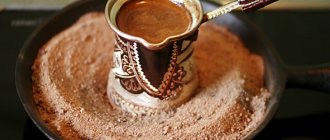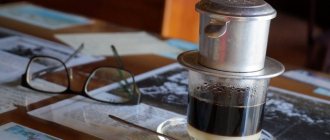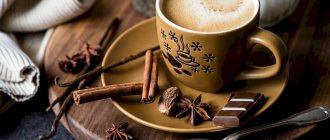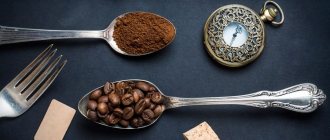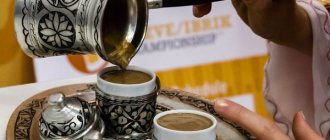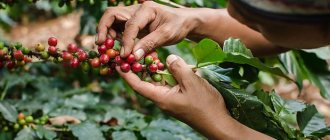History of the drink
Vietnam was a colony of France for a long time - from the 1880s to 1954. In 1857, Catholic missionaries brought the first coffee bushes to the country from the French island of Reunion. The colonists found it economically profitable to produce coffee for export. In 1908, new species were introduced into the country - robusta and liberica. In 1945, trees occupied an area of about 10 thousand hectares, and about 4,500 tons of product were produced annually. Most of the products were supplied to France.
The focus on the global market appeared after the creation of the Socialist Republic of Vietnam in 1976. The scale of coffee production doubled, and large state cooperatives emerged.
At the end of the 1970s. There is an active development of the Central Highlands (Tainguen) - a plateau in the south of the country: many coffee fields have appeared there. Since 1989, the integration of the Vietnamese economy into the world economy began, and by 2000, the coffee industry (compared to 1976) had grown 100 times.
In 2001, Vietnam joined the International Coffee Organization and the Association of Coffee Producing Countries. The country began to curb the production of low-quality raw materials in order to meet international standards. In 2009, the share of Vietnamese coffee amounted to 18% of global coffee production; Vietnam is second only to Brazil in terms of exports.
At the end of 2021, the World Coffee Museum was opened in Dak Lak province. Equipped in the style of the dwellings of the ethnic peoples of the Central Plateau, it recalls the time when new territories were being developed for plantations.
Introduction
Vietnam was a colony of France in the 19th century, so coffee was first introduced to the country by the French in 1850. In just a few years, Vietnam began to use large areas for coffee cultivation. Initially, production focused on low-quality Robusta beans.
After gaining independence, the Vietnamese developed coffee into their own beverage, improved its quality by growing different varieties of coffee beans in Vietnam, and improved the cultivation and export system. Today, Vietnam is the second largest coffee producer in the world, just after Brazil.
Vietnamese coffee provinces
The first fields appeared in 1888. They were located in Nghe An province. Then they started growing trees in the southern provinces - Thanh Hoa, Ha Tinh, and in the central ones - Quang Binh and Quang Tri.
Climatic conditions affected the taste and aroma of the product.
Vast fields - more than 600 thousand hectares - appeared in 1898 on the Teing Guen plateau, in the Central mountainous region. The optimal climate for growing coffee raw materials is in the vicinity of the city of Dalat (Lam Dong province), and the largest coffee shops are located in the city itself, which is called little Paris.
The main grain producer is Dak Lak province. Plantations covering an area of 506 thousand hectares produce an annual harvest of about 1 million tons. The administrative center of the province, Buon Ma Thuot, is considered the capital of coffee.
In modern Vietnam, plantations are located in almost every corner of the country. The plots are numerous and small: from 1 to 5 hectares, only 1% of all products are grown on plantations larger than 5 hectares.
Characteristics of coffee
As a raw material, it is represented by 2 popular pure types:
- Arabica (accounts for about 14% of all products);
- robusta (85% of production).
Robusta is a strong variety that contains almost 3 times more caffeine than Arabica. It is inexpensive and therefore forms the basis of Vietnamese drinks. More expensive Arabica is the basis for elite varieties or is added to Robusta to give a delicate flavor.

Robusta forms the basis of Vietnamese drinks.
Vietnamese coffee is exported in ground, instant and bean forms. In Russia, ground and instant products are still rare.
Taste characteristics
The drink has a rich taste and strong pleasant aroma, and is less bitter than Brazilian or Indonesian coffee. May have the following flavors:
- chocolate;
- vanilla;
- caramel;
- cream;
- nuts.
These characteristics depend on the characteristics of the variety, production, roasting and the ratio of Arabica to Robusta.
Beneficial features
The chemical composition of coffee has a beneficial effect on the human body:
- caffeine - reduces fatigue, increases productivity, speeds up metabolism;
- vitamin P - strengthens capillaries;
- antioxidants - prevent the aging of the body, reduce the risk of developing cancer;
- chlorogenic acid - normalizes the functioning of the gastrointestinal tract;
- trigonelline - prevents the development of atherosclerosis;
- nicotinic acid - lowers cholesterol levels;
- polysaccharides - increase brain activity;
- tannins - improve digestion.

In addition, coffee:
- stimulates the functioning of internal organs and mental activity, so its moderate consumption is the prevention of Alzheimer’s and Parkinson’s diseases;
- eliminates migraine;
- is an antidepressant;
- has an antiallergic effect, because reduces the level of histamines;
- helps with intoxication of the body with drugs or poisons.
Despite the extensive list of beneficial properties of the product, it is not recommended to exceed the daily norm of the drink - 3-4 cups of 240 ml.
Production Features
Peasants prefer to plant coffee trees next to fruit trees or just tall plants that bring additional income, such as corn.
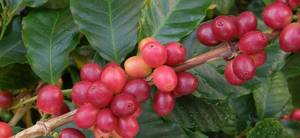
Coffee trees are planted next to fruit trees.
In the natural shade, the berries ripen longer and absorb more nutrients, which will later provide the drink with a rich taste.
Harvesting:
- Robusta - September-October. Ripe fruits can hang on a branch for a long time without falling off. This allows you to start harvesting when almost all the berries are ripe. Robusta is harvested using the stripping method - with a sliding movement of the hand, the fruits are peeled from the branch onto a canvas spread on the ground.
- Arabica - September-October. The fruits ripen unevenly; 2-3 approaches to one tree are required to collect the entire harvest. The method is called manual picking, i.e. Ripe berries are selectively collected, leaving the green ones to ripen.
Mechanized processing of collected berries is carried out only in a few large factories. Basically all work is done manually.
The technology is different:
- Dry or natural method. The fruits are scattered in a thin layer on a canvas or in a sieve and left to dry naturally for a week. Periodically stir with your hands or a spatula.
- Semi-moist method. The berries are dried a little, then the skin, pulp, gluten and patch are mechanically removed. Wash and dry.
- Wet. Allows you to obtain high quality products; it is often used when processing Arabica beans. When washing, the fruits are immersed in water and the floating unripe berries are removed. After treatment with a depulpator (like a grater, designed to separate the pulp from the peel), the grains are sent to dry.
The next step is fermentation to remove gluten. The grains are again immersed in water for 12-36 hours.
As a result of the action of bacteria, the gluten itself will begin to peel off. The grains are then dried and, after hulling (husking), manually sorted and either packaged or sent for roasting.
Signature roast
The secret of the unique taste and smell of Vietnamese coffee is in roasting the beans along with cocoa beans. This method is used only within the country.
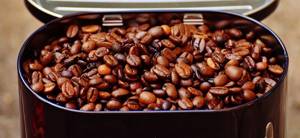
Signature roasting is the secret of the unique taste of coffee.
To give the product additional flavor shades, add:
- powdered milk;
- diluted condensed milk;
- fruit syrup;
- sugar;
- hazelnut or walnut oil.
Classic Vietnamese coffee is highly roasted; coconut oil is added to the cocoa beans.
Varietal varieties
In addition to Robusta and Arabica, there are also Liberica and Excelsa, but they are used very little. There are more than a hundred varieties.
Robusta
It is believed that Vietnamese robusta is more tasty and of higher quality than Asian or African. These are high-yielding and unpretentious trees. They prefer warm climates, but tolerate temperature changes well. Due to the high caffeine content (up to 2% per 100 ml of drink), the beans are rarely attacked by insects and therefore do not require mandatory chemical treatment. To soften the taste of the drink, robusta is mixed with Arabica in equal proportions.
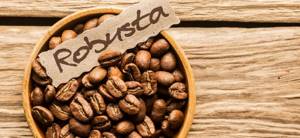
Robusta is a bean containing large amounts of caffeine.
Arabica
The plant is whimsical; in case of unfavorable conditions, the yield is reduced. Plantings may require additional watering. Arabica coffee accounts for only 10% of all fields.
Without an admixture of Robusta it is almost never consumed. The drink has a slightly sour berry taste and a nutty aftertaste.
Excelleza (shari)
Another name is Excelsa. Trees are sensitive to weather conditions and produce crops irregularly. The spreading crown makes it difficult to collect fruits. Expensive grains are used to prepare elite blends. Shari contains a small amount of caffeine and gives the drink a distinct herbaceous flavor.
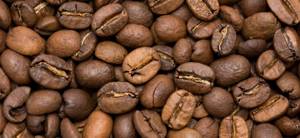
Excelleza is an elite variety that is usually used to create blends.
Coolie
Kuli is a rare and expensive drink made from selected Arabica and Robusta beans. It is produced only in Daklak. It is considered an excellent natural energy drink.
Katimor
A luxury mix of Arabica varieties Hibrido de Timor and Cattura, which is difficult to purchase even in Vietnam. The drink is valued for its fruity aftertaste.

Katimor is a hybrid of two coffee varieties.
Kopi Luwak
In Vietnam, Kopi Luwak coffee is called chon. To obtain it, whole ripe coffee fruits are fed to musangs (palm martens). Animals cannot digest grains, which, after undergoing fermentation in the digestive tract of the animals, are released with droppings. The raw materials obtained in this way lose the bitterness characteristic of coffee. Due to the labor-intensive and specific production method, the chon is the most expensive in the world.
The drink has a pronounced chocolate taste with a berry aftertaste. It is believed to have healing properties.
Blends
Mixtures of varieties, according to experts, are more refined than the pure variety. They are Robusta and Arabica in a percentage ratio of 60/40 or 70/30. Elite blends contain a certain percentage of other varieties, such as chon.
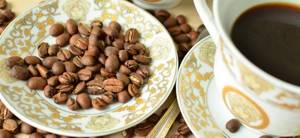
Blends are a mixture of Robusta and Arabica varieties.
Moka
Another name is mocha. It is prepared using Arabica beans and coconut oil is added during roasting. The drink contains little caffeine and has a delicate caramel taste.
Coffee in Vietnam, varieties and varieties
One of the things you should definitely bring back from Vietnam is Vietnamese coffee. You can buy it either for your own use or as a gift for family and friends, especially since gift packages are available for sale complete with a special Vietnamese brewing cup. There are no restrictions on its export from the country and import into the Russian Federation , as long as these are not commodity consignments, otherwise a question may arise from customs upon entry, and its weight does not exceed the restrictions for carrying luggage on an airplane.
Vietnamese coffee with condensed milk
For most Russians and citizens of other countries of the former USSR, Vietnamese coffee is still unknown, but Vietnam is the world's second-largest coffee exporter after Brazil, supplying foreign markets with more than 18% of total world production, and this figure is growing. It is not yet possible to find it on the shelves of Russian stores in its pure form under Vietnamese brands, and therefore the only option to get it is to bring it with you from trips to this country. You can also buy it in Russia in online stores, but the price with delivery will be 3-4 times higher than at home. True, there is an opinion that the cheapest Vietnamese coffee is processed and sold here under the guise of world brands.
Coffee on a plantation in Vietnam
Coffee from Vietnam is, without exaggeration, wonderful. Perhaps some special connoisseurs of this drink may find it too coarse and bitter, which is due to the characteristics of the variety grown (but more on that below), but it is certainly no worse than the one that lies on the shelves of our supermarkets. After all, even the most inexpensive varieties of coffee from Vietnam are pure, without any impurities of husks and dust, which, apparently, are added by packaging manufacturers in the Russian Federation to the raw materials to increase profits.
The variety grown primarily in Vietnam is Robusta, which is considered more bitter and less refined than Arabica. At the same time, Robusta contains twice as much caffeine, which gives this drink a miraculous invigorating effect. Arabica is also produced, but this variety is 30 percent more expensive, and there is very little of it. There are other varieties: Culi, Royal Special, Mocca and others. Packages of ground coffee are sold mainly in the form of mixtures of varieties, which, according to gourmets, is better than the pure variety.
Several brands of coffee from Vietnam
Elite varieties are also sold everywhere, including the famous Luwak Coffee (from mongoose) and Weasel Coffee (from weasel). The last two species are native to Indonesia, although they have taken root well in Vietnam. This coffee is made from the feces of animals, for which they are first fed fresh beans, and then these beans, partially digested, are cleaned and prepared for sale. However, given the volumes of them sold here, the conclusion suggests itself that this is a fake, especially since in 2021 one of the largest companies, Trung Nguyen, was caught supplying fake Luwak to restaurants. In any case, if you are not a specialist and a gourmet, you will not feel the difference between these types and simple varieties, but you will overpay tenfold. Therefore, we would not recommend purchasing these varieties.
As for bulk beans, they are found mainly in two pure varieties - Robusta and Arabica. Moreover, Arabica is a more expensive variety. In order not to get caught in a substitution, the variety is quite easy to identify by the shape of the grains:
- Robusta is an almost round grain with an even cut in the middle.
- Arabica is an elongated, oblong grain with an uneven cut in the shape of the letter S.
Difference between Arabica and Robusta beans
Famous brands
Coffee products are mainly produced on small farms. But there are also large companies whose products are known outside the country.
Me Trang
One of the best brands in the country. It emerged in 2000 and today unites a network of 19 branches. The company constantly improves product quality by modernizing processes. "Mechang" produces ground products, soluble and in grains. It has a large line of varieties (Chon, Robusta, Arabika, AR mixture), and supplies the market with recognizable red-brown packaging.
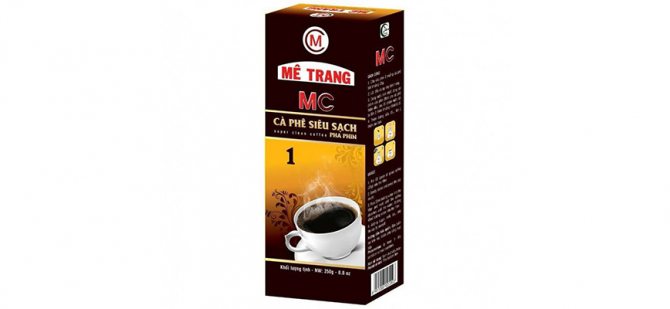
Me Trang is a high quality invigorating drink.
Con Soc
The products of this company can be easily recognized by the squirrel shown on the packaging. The company produces 2 varieties - Arabica (brown background on the packaging) and Blend (blue background). The raw material is grown on the Lam Dong plateau in Da Lat.
Distinctive features of production:
- When roasting beans, walnut oil is added, which removes bitterness from the drink and gives it a nutty flavor.
- Fine grind. It is better not to brew the powder in a classic press filter. The company itself recommends using paper filters.
Trang Nguyen
Vietnamese brand, popular all over the world. Exports products, including instant products, to 25 countries. The most popular product is an equal mixture of Arabica and Robusta Ocean Blue. Recognizable packaging with an image of an airplane or yacht.
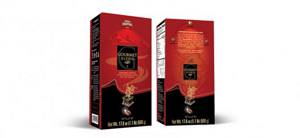
Trang Nguen is the largest and most famous Vietnamese coffee producer.
Trang Nguyen includes subsidiary brands G7, Weasel kopi luwak, Passiona, Legendee and Creative.
Phuong Vy
Established in 1954, the company has its own plantations in Dak Nong and 2 factories that separately produce products for export and for the domestic market. Multi-stage processing of beans and complex caramel roasting give the product a signature taste.
Dong Phuong
A leading bean processing company, founded in 1995. The coffee of this premium brand is distinguished by high-quality roasting. Popular types are Espresso and Phoenix.
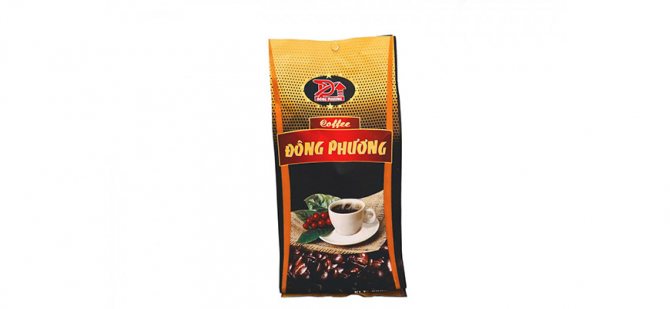
Dong Phuong is a coffee that is distinguished by high-quality roasting.
Tam Chau
A fast-growing company little known in Russia. Produces coffee and tea products for import and export. The plantations are located in Lam Dong.
Rozano
The company was founded in 2000. It produces ground and grain products from specially refined raw materials.

Rozano produces ground and grain products.
Where to buy and how much coffee costs in Vietnam
Coffee in Vietnam is sold at almost every turn: in bazaars, coffee shops and souvenir shops, supermarkets with fixed prices, pharmacies, cafes. Most often it is ground and bean coffee. For future use, it is better to take it in grains, so it will last longer and will not fizzle out. The aroma and flavor bouquet will be revealed best if you brew freshly ground coffee. You'll start having fun early.
In supermarkets, the price of a 500 g package of ground coffee starts from 65,000 Vietnamese dong. One thousand dong is approximately 3 Russian rubles. It's easier to translate if you remove the zeros from the thousands and multiply by three. In markets and souvenir shops, the price can reach up to 120,000 VND.
In coffee shops the choice is much wider, but there is no guarantee that they will not be deceived and sell cheap coffee at exorbitant prices. They will offer you a high-quality, expensive drink to taste, and then sell you a pack with cheap coffee inside.
Depending on the type of coffee, the price for 500 g starts from 2.5 dollars. There are also elite blends, prices for which start at $50 per 225 g package. Popular varieties are sold in the range of $5-10 per 500 g.
In Vietnam, you can also buy coffee in cafes. One of the best options, in fact. Come, order coffee, if you like it, ask to sell this particular coffee. Coffee shops here make money not only by hosting guests, but also by selling products.
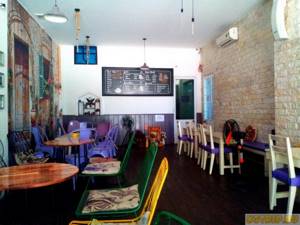
It is believed that the best coffee in Vietnam is in Dalat, around which there are huge coffee plantations. However, experienced tourists notice that as this place is promoted, prices rise. It cannot be said that coffee is definitely cheaper when planted. It also happens in Nha Trang that you come across a local shop where they sell excellent coffee at a reasonable price.
We advise you to take a little from different places. Then there won’t be much overpayment, and there’s a better chance of buying high-quality grains. If you are unlucky in one place, buying from another location may turn out to be successful.
Cooking instructions and recipes
Vietnamese coffee can be prepared in a coffee maker. It is rarely brewed in Turk, because the drink prepared in this way gives off bitterness. It is best to use the Vietnamese brewing method in a special brewing cup - a fin filter.
Preparation procedure:
- Place the teapot on the mug and pour coffee into it (from 2 to 4 tsp). Shake lightly so that the powder is distributed evenly at the bottom.
- Compact the top with a press. Do not tamp too hard, otherwise the liquid will not flow well into the mug. Pour a little boiling water to steam the grounds. Wait about 15 seconds.
- Pour boiling water to the edges of the fin filter or less, depending on the desired strength. Close the lid.
- The liquid will drip through the filter into the cup for about 4 minutes. When the process stops, the coffee is ready.
The infusion prepared in this way will serve as the basis for creating various drinks.
With ice
Place condensed milk and ice in a blender, pour in the prepared coffee and blend.

Iced coffee is a soft drink.
With rum
Add 1-2 tbsp to the finished robusta. l. Roma
With egg
Place a “cap” of eggs beaten with sugar or condensed milk on top of the coffee. First, eat the fluffy egg-sweet mass, then drink a hot or iced drink.
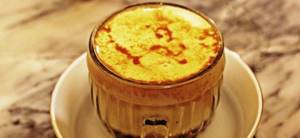
Coffee with egg is an unusual drink option.
With condensed milk
Place condensed milk to taste at the bottom of the cup. Place a fine filter on the cup and prepare coffee. The milk should dissolve on its own, without stirring.
With yogurt
Place 3 tsp in a cup. yogurt and pour unsweetened coffee.

Vietnamese coffee can be made with yogurt.
Smoothie
Fruit mixtures, such as avocado and banana, are mixed with the drink in arbitrary proportions.
Vietnamese coffee
The Vietnamese do not brew coffee in Turks or use espresso machines: they adapted the French press, turning it into a “dripping filter” - phin. The structure is placed directly on the cup, 2-3 teaspoons of coarsely ground and heavily roasted robusta are poured into the flask, then about 100 ml of boiling water is poured in and wait until the water seeps through the coffee into the cup. If the cup is not full, you can add more water. If the Vietnamese want to add condensed milk to their coffee, they pour it to the bottom of the cup to taste before preparing the coffee.
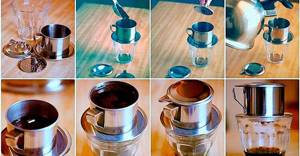
Step-by-step process for making Vietnamese coffee
In Vietnam, you can hardly find the usual espresso, cappuccino or latte. Also, only international chains like Starbucks prepare European takeaway coffee here.
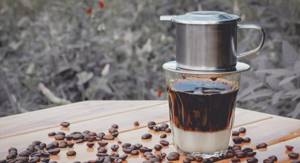
Classic Vietnamese coffee. Bottom layer – condensed milk
Instead, the Vietnamese developed their own recipes:
- Cà Phê Sữa Đá – ice coffee. First you need to prepare regular coffee using a phin filter, then pour it into a blender, add condensed milk and ice to taste, and beat well. The variation without condensed milk is called Cà phê đá, it is very strong and bitter. That's why the Vietnamese themselves drink this coffee with a generous portion of sugar.
- Cà phê dừa – coffee with coconut milk. Coffee is prepared in the usual way, in a filter (6 parts), cooled (or not, to taste), then a mixture of condensed milk (1 part) and coconut milk (2 parts) is poured into it in a thin stream.
- Cà Phê Trứng – coffee with egg. It sounds scarier than it actually is: beat the egg yolk with sugar until a fluffy foam forms, then spoon this mass onto hot coffee. The egg is baked on the bottom, resulting in something like a sweet creamy glaze or meringue.
In addition, types of Vietnamese coffee include coffee with yogurt (layers, a fermented treat on the bottom, an invigorating drink on top), coffee with fruit smoothies, and coffee with green tea.
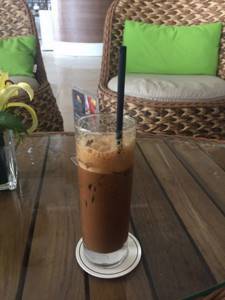
Cold coffee
The French also brought condensed milk to Vietnam: the body of an adult European does not tolerate fresh milk well.
The nuances of serving and drinking
Vietnamese coffee traditions have their own characteristics:
- The drink is served in glasses or special mugs.
- Coffee is not boiled, but brewed in a metal dropper cup with holes in the bottom.
- The default drink is as strong and sweet as possible. If you want it without sugar or condensed milk, you need to ask the barista about this in advance.
- It is not customary to serve cookies and other desserts with coffee, since drinks are almost always prepared with hearty additives, for example, condensed milk or egg.
How the Vietnamese themselves prepare coffee
Video: How to brew Vietnamese coffee filter prepare coffee in Vietnamese
The characteristics of Vietnamese coffee varieties determine the nature of their preparation. No one makes coffee in Turk in this country. Processed in this way it will taste too bitter. In order to get a delicious drink, the Vietnamese use special aluminum filters complete with special presses. The filter is installed on the cup, coarsely ground coffee powder (fraction diameter 2-3 mm) is poured on top. Then this structure is pressed with a press and poured with boiling water. The brewing time is 4-5 minutes, after which you can drink the coffee.
Another popular option is coffee with condensed milk. Unlike our compatriots, who add condensed milk to coffee, the Vietnamese do the opposite - pour coffee into condensed milk. At the same time, condensed milk takes? cups, and coffee is poured on top of it. In this case, you cannot stir the drink. The milk should dissolve into the coffee on its own. Very often, a filter is placed on a cup of condensed milk, and the coffee slowly drips onto the milk.
Another popular option is coffee with eggs. Beat the egg until creamy and place it on top of the coffee. This creme brulee-like layer must first be eaten with a spoon, after which you should drink coffee, which can be either hot or cold. In the case of hot coffee, place the coffee cup in a bowl of boiling water; in the case of cold coffee, place it in ice water.
Video: How to make Vietnamese coffee
Places of sale and cost of coffee in Vietnam
It is better to buy coffee from well-known stores rather than from the market. The Me Trang and Crazy Shop chains of coffee shops and Big-C supermarkets enjoy a good reputation. Their prices are significantly lower than in Russian stores (see table).
| Ground coffee price | ||
| Name | Packing | Price, dong/rub. |
| Cafe Me Trang Arabica | 500 g | 58500/183 |
| Highland Coffee Culi | 200 g | 47000/147 |
| Trung Nguyen Nau Suc Song | 500 g | 50600/159 |
| Coffee Gourmet Blend | 200 g | 39700/124 |
| King Coffee Expert Blend | 500 g | 41900/131 |
Among the bean coffees, especially noteworthy are Cafe Me Trang Arabica (500 g - about 420 rubles) and Phuc Long Robusta (200 g - about 147 rubles).
In shops for tourists there is a risk of buying a fake, and their prices are too high. It happens that sellers pass off Robusta as a more expensive Arabica. But it's easy to distinguish them:
- Arabica - elongated grain, wavy longitudinal stripe;
- Robusta is a round grain with a straight stripe in the middle.

You can drink a cup of coffee both on the street and in a cafe.
Average cost of a glass:
- on the street - $1;
- in a cafe - 1.5-2 $;
- in a restaurant - $2.5.
Permitted quantity for export
There are no restrictions on the export of coffee from Vietnam and its import into Russia, the main thing is that the weight of the purchase does not exceed the allowable weight for luggage. For consignments, it is necessary to prepare the appropriate documents for customs.
Main types of coffee in Vietnam
ARABIC
Also known as "tea" coffee (due to the similarity of the leaves to the tea tree), usually grown at an altitude of 1000 to 1500 m. Arabica has always been and will be valued for its delicious taste and aroma.
Arabica has a sour taste mixed with a bitter tint. The color when brewing is light brown, amber. Arabica , grown on Dalat plantations, has a famous “noble” aroma that has been idolized by the Vietnamese nobility since the late 19th century.
A wonderful combination of Arabica varieties Cau Dat, Uan Trung, as well as a special roasting technology - this is the best Vietnamese Arabica . Arabica plantations in Vietnam is a very small area, only about 3% of all coffee plantations. Arabica cultivation area is encouraged by the state.
ROBUSTA
This is the soul of Vietnamese coffee . Robusta coffee (Coffea Canephora) is the second most important coffee in the coffee varietal, and by far dominates world exports. About 39% of the world's coffee products are made from the Robusta . Vietnam is the largest exporter of Robusta coffee in the world.
In recent years, Vietnam has become the No. 1 exporter of Robusta in the world. The largest importers of Vietnamese Robusta are Germany (12.3% of the market) and the USA (12.2%). Robusta grows in Vietnam at altitudes ranging from 500 m to 1000 m, at temperatures ranging from 24 to 29 degrees Celsius, without herbicides or pesticides.
Robusta plantations account for 90% of all other coffee plantations in Vietnam . The city of Buon Ma Tuot (Dac Lac province) is the capital of Vietnamese coffee , and is also famous for its largest Robusta .
COOLIE
Also known as round coffee. Unlike regular coffee, Kuli coffee has only one grain in the berry. Due to its unsurpassed taste and unique aroma, the Vietnamese called this coffee the “pearl” of the coffee .
Kuli is fried in a special mode so that the delicate and expressive taste is fully preserved. Kuli a characteristic taste due to the basalt lands on which it grows. Product features: light brown tint, smooth taste, aromatic, persistent, long aftertaste.
CHERRY
Also known as Liberica and Exelsa (originally planted in the Chua Chan - Long Kan mountain ranges). Also, quite often Cherry coffee is called jackfruit coffee (due to its similarity to the jackfruit tree).
This type of Arabica is very rare and quite popular outside of Vietnam, cherry is also very resistant to pests and has a high yield. It is grown in dry, arid highlands where strong winds prevail.
Cherry coffee has a distinctive taste and aroma (this taste is achieved by partially roasting the beans in the so-called “honey shell”). The grains are shiny and even, the color of the grains after roasting is “dark gold”.
Cherry coffee is roasted in several stages: 1) when a pleasant, subtle smell appears, the roasting stops and the coffee beans cool; 2) after a few hours, the roasting continues, which is why the cherry aroma appears. Elegant cherry sourness and a long aftertaste are the hallmarks of this type of coffee.
TYPE
Typica is a proto-varietal of Arabica. Typica was the first coffee discovered in the Caffa region of Ethiopia (East Africa), which is why Typica is considered the world's first coffee bean. This coffee is also used as a basis for breeding other varieties of coffee.
Until 1988, in the city of Cau Dat (Dalat), almost all plantations consisted of Typica and Bourbon - two varieties of coffee with excellent taste. But, due to low yields, the Vietnamese stopped growing these proto-varieties of coffee, and only in 2008, Typica and Bourbon plantations were planted again in Vietnam.
Typica grows in Vietnam exclusively in Lam Dong province, Cau Dat city, at an altitude of 1300 m above sea level. Typica is less common in Vietnam than any other coffee - this is the value of Typica.
Features of Typika: perfect roasting at 220 degrees Celsius, the color of the beans is light brown. Excellent taste and long aftertaste, with a slight aftertaste of citrus, no pronounced sourness or bitterness, the ideal taste of coffee for gourmets from Vietnam!
MOKA
A variety of Arabica , brought by the French in the 30s of the 20th century to Vietnam. Mocha (Mocha) is the name of the port city of Mocha in Yemen, where coffee first arrived from Africa. French agronomists created identical conditions for the growth of Moca - on the hills of the Lam Chau Plateau, at the same latitude and altitude as in its homeland in Yemen (over 1600 meters above sea level).
Arabica varieties , this type of coffee tree is the most difficult to grow, requiring intensive treatment against various pests and diseases, requiring exceptional environmental conditions and specialized fertilization methods. Moka coffee can only grow at altitudes above 1500 m, so it cannot be planted in Dak Lak, the capital of Vietnamese coffee.
Thus, in Vietnam, Moka is a very rare coffee , its cost is always higher than the cost of other types of coffee . Despite all these conventions and difficulties in growing this subspecies, 27% of Arabica coffee consumed worldwide is Moca .
It's safe to say that Moka is the king in the kingdom of coffee , the beans are much larger and more beautiful than other varieties. The aroma of this coffee is special, it exudes luxury and rave reviews. The slight sour taste is elegant. Moka also contains the least amount of caffeine than any other type of coffee . Countries such as the USA, Australia, France are the main exporters of this coffee from Vietnam .
BOURBON
Bourbon coffee is a variety of Arabica and comes from the island of Bourbon. The peculiarity of this type of coffee is a long tobacco aftertaste and a slight sourness, turning into a weak bitterness.
In Vietnam, this variety is quite rare and is considered not productive, therefore not popular. A total of 8 farms have taken on the responsibility of growing Bourbon coffee, all of which are located in the vicinity of the cities of Dalat and Cau Dat.
The fruits are dried directly on the coffee tree until the beans turn yellow; the harvest is harvested exclusively by hand, in three stages. Also, the Vietnamese customarily roast Bourbon with salt to give this type of coffee some piquancy and a distinctive aftertaste.
HONEY PROCESSING
A relatively new term that describes the process of processing Arabica coffee berries, in which part of the pulp or “honey shell” (in English honey) remains on the bean and goes through all stages of drying.
In essence, this method is a good, high-quality alternative to the washed method (complete removal of pulp from the surface of the bean) of processing coffee beans or the natural (natural drying) method of processing. The honey process can also be considered the most environmentally friendly method of coffee production.
Only Arabica and its various types (Typica, Bourbon, Catimor, etc.) are suitable for this method.
Read more about honey processing...
Dear readers! We have our own channel on YOUTUBE: Alphaviet, where you can watch interesting videos about Vietnam and Nha Trang in particular, subscribe and watch our videos first!
Latest VIDEO about Vietnamese LUVAK: what it tastes like and how it is produced.
Contraindications for use
Coffee can provoke undesirable consequences if a person has diseases and problems such as:
- insomnia;
- anxiety states;
- heart diseases;
- hypertension;
- stomach diseases;
- cholecystitis;
- glaucoma;
- cirrhosis of the liver.
Is it possible to occasionally allow yourself to drink a cup of aromatic drink if you have such pathologies? It’s better to check with your doctor.
In the producing country, coffee is today the second most exported product (after rice), but in Russia it is just beginning to become widespread, so the packaging of the original drink will be a good souvenir from Vietnam.
What kind of coffee grows in Vietnam?
95-97% of coffee from Vietnam is Robusta
Vietnam “specializes” in the production of robusta, and this is due to the fact that robusta can be grown at low altitudes, the plant is resistant to diseases and harmful insects (insects simply cannot withstand such caffeine content).
And most importantly, the robusta tree produces a very large harvest.
The result is a lot of cheap coffee, which is great news if flavor and aroma are left out. Many will argue that they love the taste of Vietnamese coffee and that they have never tasted anything tastier in their life. How this happens, you will find out below.
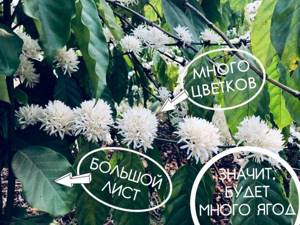
Flowering Robusta tree in Vietnam, near Dalat
